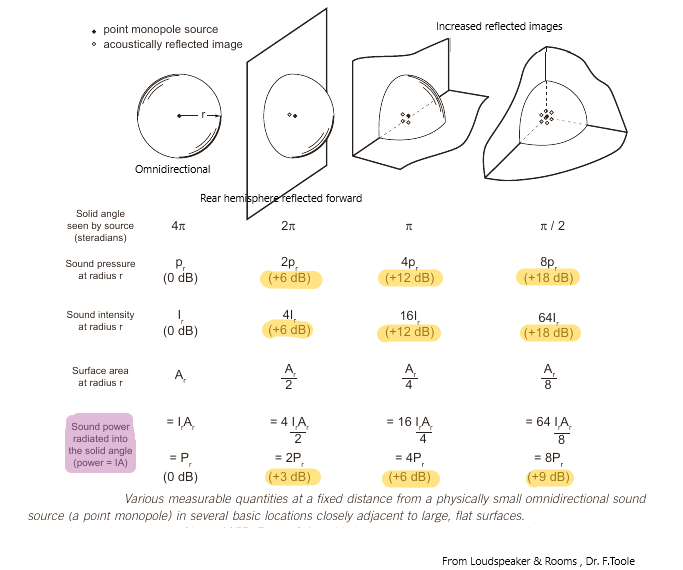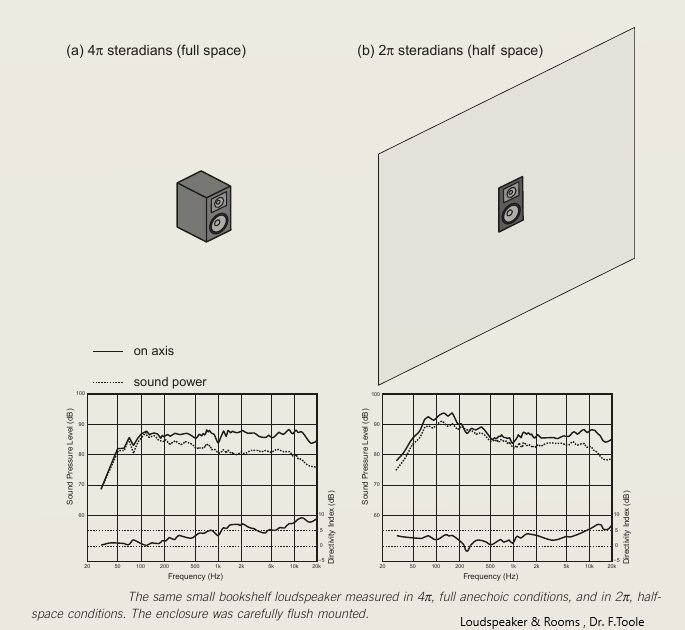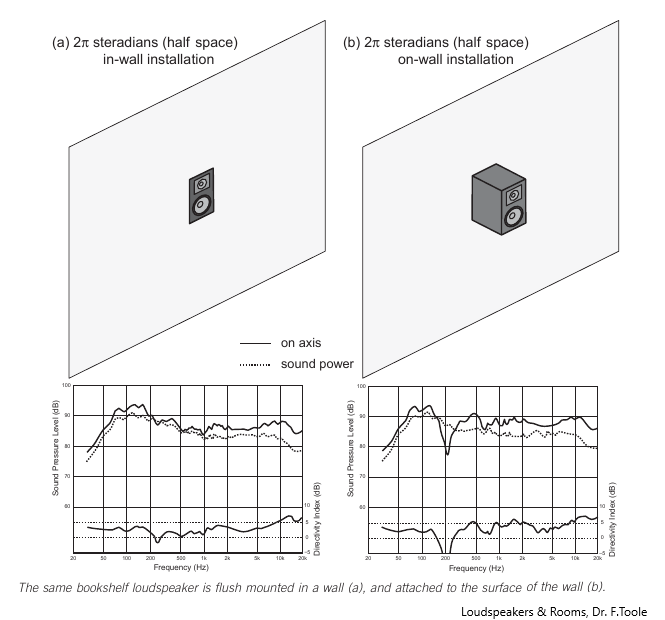Small Rooms & Speaker Mounting.
A speaker’s behavior in a room can be approximated as the combination of the wall adjacent to the speaker and standing waves.
Effect of the wall interactions is much more prominent when the speaker is placed less than a wavelength from any wall. Depending upon the distance, the energy radiated into the room is affected by the “adjacent wall effects”.
Before we talk about the solution first we need to understand what the problems is. Lets talk about what happens when speakers are placed within distance that is only a fraction of a wavelength.
25 Hz= 45.2 Ft , you see this is particularly large for any practical room, if you are thinking about avoiding the wall interactions . So, now you know no matter what until you are in a very large room (all dimensions exceeding all wavelength of interests , i.e. for 20 Hz Length, width , height all three have to be more than 57 ft.) , you are going to have “speaker boundary interactions”. So cases when the wavelength is too large compared to the distance between the speaker and the wall the sound will be seen as omnidirectional.

The area into which the sound is radiated is called the solid angle of the speaker, an omnidirectional source has 4𝜋 solid angle. So what you need to remember from this is, SPL at any constant distance rises by 6dB for each halving of solid angle of speaker. In other terms the speaker’s sensitivity mentioned in the spec sheets by the manufacturer is for a free field zone where no walls are present. The placement of the speakers in your room thus affects the sensitivity and solid angle of speaker.
Note , 3dB increments are only seen in case of radiated sound power not sound pressure. SPL always follow a 6dB change. We are interested in knowing SPL , so halving of solid angle would result in a 6 dB change always. Keep in mind we are only talking about the wavelengths that would be seen as omnidirectional. The 6dB difference start to quickly vanish around 200-300 Hz depending upon the speaker size and the Schroeder Frequency. Thus creating null points in the sound output. Speaking of, pressure & nulls points or nodes(N) and antinodes(A) are the movement of air particles due to sound pressure level created by the speaker.
In practical rooms the solid angle gains are reduced by spatial averaging of data and surface absorption in the room. What’s heard in a room at low frequencies is not likely to be anticipated from just examining the anechoic data provided by the manufacturer. Measured & computed data without complex FEM, BEM methods is only effective above 200 Hz.
In other terms the data provided by the manufacturer is a representation of the speaker radiating sound in a omnidirectional pattern below 200 Hz, where the room dimensions dominate the sound perceived and sound radiated in presumed omnidirectional pattern even above 200 Hz which actually is not the real case as will be shown below how speakers tend to get directive in nature(not omnidirectional) and how their directivity characteristics affect the perceived sound.
Above all non real assumption above 200 Hz, your speakers solid angle is changed by the mounting you choose. It’s getting messy.
Compensating for speaker boundary effects , it is required to place the speaker with respect to walls so that it minimizes the variations in frequency response from seat to seat. It is also to some extent achieved via equalization for electronic alteration of the speaker’s response. Then again not preferred to equalize too much as it’s like you being the mix engineer and altering the balanced mix. It would for sure sound different , just not good different if you don’t know what you are doing.
Averaging several measurements help show the effects of wall interactions , which can be used a guideline for the correction to match target curve. Equalizing the very heavy peaks or sharp resonances is what you should be aiming for. Remember , this would be only 100 % replicated for the sweet spot , room resonances would still interfere with the signal and thus would sound different from seat to seat.
Speaker Mounting Options
Directivity Index is the measurement of the speakers response which tell us about the speaker’s directional characteristics at different frequencies.
Ideally you would want a speaker to radiate sound in all direction equally , as in case of a omnidirectional source.
On Earth , the speakers are less than ideal meaning they have a throw which has a limited solid angle which is less than 4𝜋. These are generally called as coverage angles of the speaker, measured both vertically and horizontally. As human auditory perception is more sensitive to horizontal l sound dispersion than what’s happening in the vertical plane, so we settle for speakers that can provide a decent coverage vertically and as much as horizontal coverage is possible from the speaker.
How this is actually observed is the frequencies above 200 Hz are affected by the speakers directional characteristics. So a rise in higher frequencies is observed, it means the Directivity Index(DI) for an omnidirectional source like your subwoofer that is just radiating low frequencies is 0. Which is a good thing, 0 dB of DI means there no directivity characteristics involved , it’s uniform all over. Meaning in a free field the perceived low frequency response of the speaker would be almost the same in different positions whether its in front of back of the speaker

2𝜋 is the best scenario you can opt for, i.e. speaker flush mounted in the wall.


In short, speakers worth 20-30k rs. would have the DI crossover somewhere around 1-2kHz with a boost of around 4-9dB in 4kHz and above region, which is so far from uniform its like seeing two different colors when watching TV from two different seats ,the same frame . On wall installation of speakers reduces the output in 200-500 Hz region , in some cases a wide null. No wonder we experience large seat to seat variation when we don’t have at least a good pair of speakers because all we see mostly are on wall installs in practical rooms, acoustics and other problems apart.
Frequency response & Sound power curves both have their own importance in showing the response of the speaker. Boundary effects are more evident in the frequency response curve in a dead room, while in a fairly reverberant room the power curve is more reliable to check for wall interactions.
In wall installation have to be done properly as well , you can notice the null right around 200 Hz in the response in the speaker when placed in a cavity. When left so, high Q resonances & diffraction effects are observed by the edges of the cavity. Notice how the response soothes out when the cavity is filled with insulation material.
Every situation is different, hence every solution is unique . For example , a room with an opening to other room( L shaped spaces) will have to be taken care of by doing in-situ measurements and coming up the proper sound field management required to provide very little seat to seat variation in real scenarios. You can probably choose to mount your speakers any way you like from the above stated scenarios, just have to know what impact it has in the room itself & how to actually blend your spices & sauces of the reproduced mix by the speaker.
How about floor standing speakers? What about the scenario if you wanna be more carful about the reflected images from the adjacent wall? what’s the safe distance to place the speakers? Does speaker size matter ? Is there a one size fits all solution to this problem?
Not getting into the whole fiasco that different manufacturers mention in setting up the speakers from the front wall if you don’t have the luxury of installing in wall speakers, a rule of thumb you can follow when placing your speaker a specific distance from the wall is either less than 3ft or more than 12ft while maintaining a minimum distance of the diameter of the port of the speaker if incase it is facing the wall for air to move freely in that area. A speaker placed within 3-12ft of distance from the wall will cause troublesome effects, depending on the room size.
Now you know, any speaker placed in any room (until the dimensions are bigger than bandwidth of interest) at any distance from a certain wall will have huge effects over the perceived sound and it will not remain the same as radiated by the speakers itself. These are majorly due to all the wall reflections not just one. The more reflection you try to treat, the more expensive and complex it gets. That’s why studios cost what they cost.
Till now we were just talking about reflections from just one adjacent wall only.
Remember all of this was just due to one wall, when actually in a practical room 4 or more walls are involved at any instant of those millions of reflections. The smaller the room, the more the sound reflects off before dying out, thus the more problems it encounters in producing the low frequencies below a certain frequency as low frequencies tend to be as big as buildings in terms of wavelength, you can only imagine.
But none of this matters in the bigger picture if you don’t deal with the reflections of all other walls as well.
Here’s a brainer,
Speed of sound = 1130ft/s
Dividing it with the longest dimensions of your room , say for example 15ft =>1130/15= 75.3 Hz
What happens in this room below 75 HZ or what happens in your room below the wavelength of the longest dimension of your room? Why the longest dimensions? What about the shortest one?
All these questions, all the wall interactions impacts on the perceived sound has to do with the phenomenon called room modes or eigentones or standing waves. We’ll talk more about that in the continued post.
Does that mean there’s nothing you can do in a small room for low frequencies? Well all of you must have heard of sound absorption & diffusion. No? Ok. You just did. Simple as absorbing sound, so it doesn’t bounce back from a surface & diffusion, diffusing the incident sound wave in all directions after impact.
That’s all we need.
